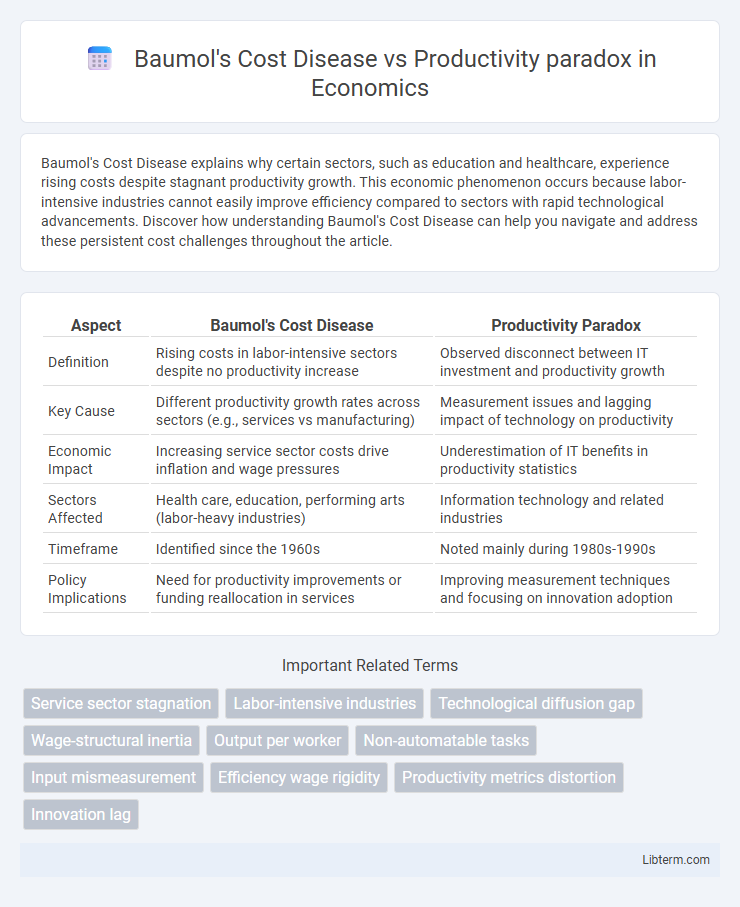Baumol's Cost Disease explains why certain sectors, such as education and healthcare, experience rising costs despite stagnant productivity growth. This economic phenomenon occurs because labor-intensive industries cannot easily improve efficiency compared to sectors with rapid technological advancements. Discover how understanding Baumol's Cost Disease can help you navigate and address these persistent cost challenges throughout the article.
Table of Comparison
| Aspect | Baumol's Cost Disease | Productivity Paradox |
|---|---|---|
| Definition | Rising costs in labor-intensive sectors despite no productivity increase | Observed disconnect between IT investment and productivity growth |
| Key Cause | Different productivity growth rates across sectors (e.g., services vs manufacturing) | Measurement issues and lagging impact of technology on productivity |
| Economic Impact | Increasing service sector costs drive inflation and wage pressures | Underestimation of IT benefits in productivity statistics |
| Sectors Affected | Health care, education, performing arts (labor-heavy industries) | Information technology and related industries |
| Timeframe | Identified since the 1960s | Noted mainly during 1980s-1990s |
| Policy Implications | Need for productivity improvements or funding reallocation in services | Improving measurement techniques and focusing on innovation adoption |
Introduction to Baumol’s Cost Disease and Productivity Paradox
Baumol's Cost Disease explains rising costs in labor-intensive industries where productivity growth is stagnant compared to sectors with rapid technological advances. The Productivity Paradox highlights the puzzling lack of measurable productivity gains despite significant investments in information technology. Both concepts reveal challenges in linking innovation and economic efficiency across different sectors.
Defining Baumol’s Cost Disease
Baumol's Cost Disease describes the economic phenomenon where labor-intensive industries, such as education and healthcare, experience rising costs due to slower productivity growth compared to other sectors. This occurs because wages in stagnant productivity sectors must increase to compete with wages in more productive industries, driving up overall service costs without corresponding output gains. The Productivity Paradox contrasts this by highlighting situations where increased technology investment fails to translate into expected productivity increases, underscoring differences in sector-specific productivity dynamics.
Understanding the Productivity Paradox
The Productivity Paradox highlights the puzzling observation that significant investments in information technology have not translated into proportional gains in measured productivity across many sectors. This phenomenon contrasts with Baumol's Cost Disease, which explains rising costs in labor-intensive industries due to stagnant productivity despite technological advances. Understanding the Productivity Paradox requires examining factors such as measurement challenges, the lag in technology diffusion, and the shift in economic output toward intangible assets and service-oriented activities.
Key Differences Between Baumol’s Cost Disease and the Productivity Paradox
Baumol's Cost Disease explains rising costs in labor-intensive sectors due to slower productivity growth compared to other industries, whereas the Productivity Paradox highlights the discrepancy between rapid technological advancement and the slower-than-expected productivity improvements in the economy. Baumol's theory centers on cost inflation in services like education and healthcare, while the Productivity Paradox questions the direct impact of information technology on measurable productivity gains. These fundamental differences underscore why Baumol's Cost Disease addresses sector-specific inflation pressures, contrasting with the Productivity Paradox's broader concern with the efficacy of technology-driven productivity growth.
Historical Context and Economic Impact
Baumol's Cost Disease explains rising costs in labor-intensive sectors like education and healthcare due to stagnant productivity compared to manufacturing, rooted in post-industrialization economic shifts of the 20th century. The Productivity Paradox emerged in the late 20th century, highlighting the gap between rapid technological advancements and stagnant productivity growth in the service economy. These phenomena collectively shaped economic policy by challenging assumptions about technology-driven growth and emphasizing sectoral disparities affecting wage inflation and public spending.
Sectors Most Affected by Baumol’s Cost Disease
Sectors most affected by Baumol's Cost Disease include education, healthcare, and performing arts, where labor-intensive activities resist productivity gains. These industries require sustained human input with limited scope for automation, leading to rising costs despite stagnant output. Contrasting with the Productivity Paradox, which highlights stagnant productivity in technology-heavy sectors, Baumol's phenomenon explains inflationary pressures in service sectors essential to society.
Factors Contributing to the Productivity Paradox
The Productivity Paradox arises from factors such as measurement challenges in capturing IT-driven output improvements, the lag between technological adoption and visible productivity gains, and the uneven diffusion of innovations across industries. Baumol's Cost Disease highlights how labor-intensive sectors with limited productivity growth cause rising relative costs, contrasting with the Productivity Paradox's focus on the delayed or muted impact of information technology on overall economic productivity. Understanding these dynamics requires analyzing sector-specific productivity metrics and the role of intangible assets in modern economies.
Implications for Wages and Economic Growth
Baumol's Cost Disease explains rising wages in low-productivity sectors like healthcare and education despite stagnant output, causing cost inflation without productivity gains. The Productivity Paradox highlights slower measured economic growth despite technological advances, raising questions about productivity metrics and wage dynamics. Together, these phenomena imply wage growth in service sectors outpaces productivity, exerting pressure on economic growth and labor market efficiency.
Strategies to Address Cost Disease and Productivity Stagnation
Strategies to address Baumol's Cost Disease and the Productivity Paradox include investing in automation and technology to enhance efficiency in labor-intensive sectors such as healthcare and education. Emphasizing workforce training and skill development can help bridge the gap between technological advances and actual productivity gains. Reforming regulatory frameworks and encouraging innovation ecosystems promote competitive environments that support sustainable economic growth despite rising service costs.
Future Outlook: Overcoming Economic Inefficiencies
Baumol's Cost Disease highlights rising costs in labor-intensive sectors due to stagnant productivity, while the Productivity Paradox underscores the disconnect between technological advances and measurable economic growth. Future economic frameworks must integrate AI and automation to enhance productivity in traditionally stagnant industries, thereby reducing inefficiencies. Strategic investment in human capital and innovation ecosystems will drive long-term economic resilience and growth.
Baumol's Cost Disease Infographic

 libterm.com
libterm.com